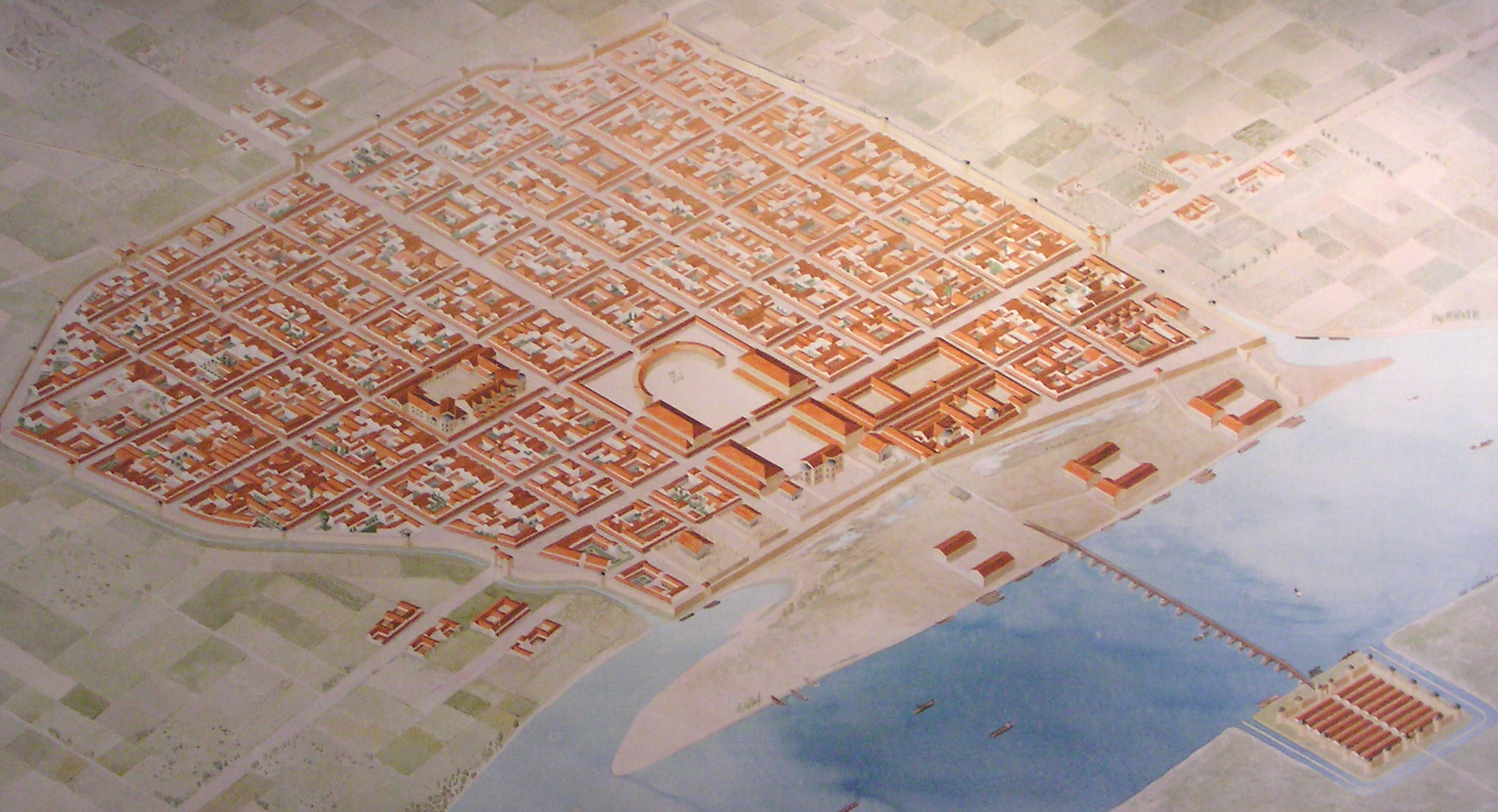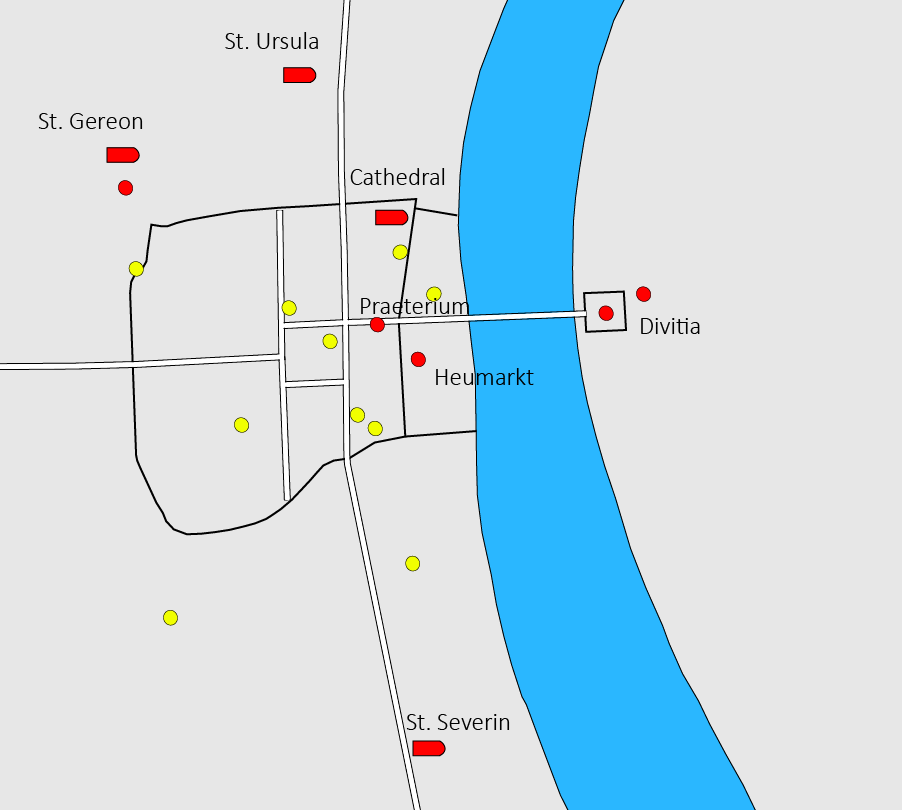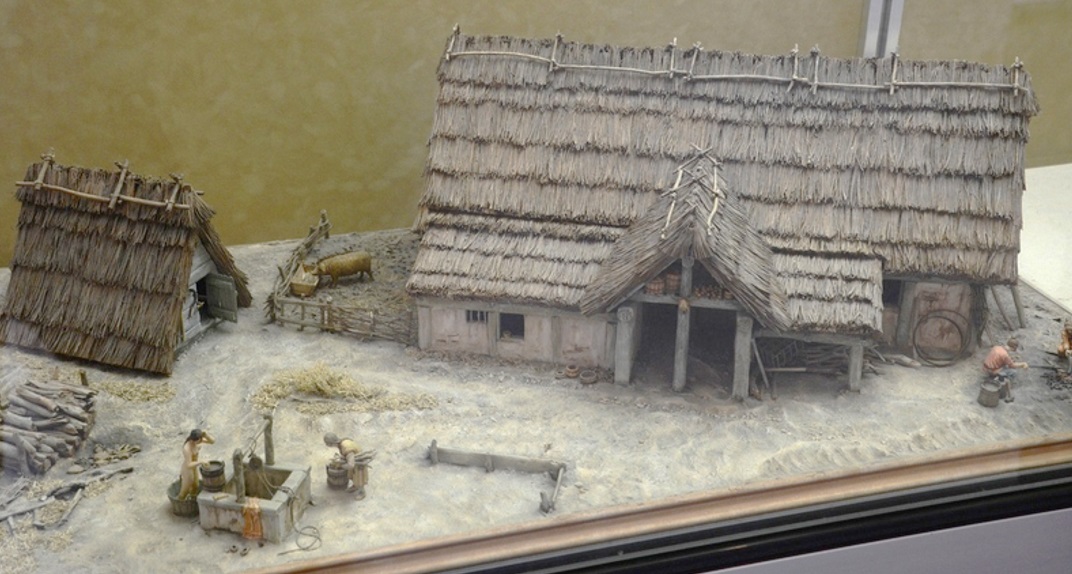A grazing field for pigs? The early years of post-Roman Cologne
New archaeological discoveries and a fresh perspective on the written sources shed new light on Cologne in the Early Middle Ages
An ‘empty shell’, ‘ghost town’, or even a ‘field for pigs’. The prevailing image of the early medieval town in northern Gaul just after the collapse of Roman authority in the fifth century is one of crumbling ruins. For a long time, preconceived notions of what an early medieval town ought to look like have cast their shadow over the evidence. But new archaeological discoveries and a fresh perspective on the written sources is starting to change this picture. Here, I will zoom in on one such town: Cologne around the year five hundred.
From Provincial Capital to Royal Seat
By the Early Middle Ages, Cologne had a long history. It had been founded in the first century by the Romans as a colony for the allied Germanic tribe of the Ubians, before its “promotion” in 50 AD to Colonia Claudia Ara Agrippinensium. It became the capital of Germania Inferior, the lower Rhine area, and remained so until the end. We know that into the fourth century the city enjoyed prosperity and even expanded, taking on an increasingly military role under emperor Constantine.

Fig. I. An idealised picture of Roman Cologne in the fourth century, featuring the latest constructions under Emperor Constantine. Source: Römisch-Germanisches Museum, Cologne, Wikicommons
However, by the fifth century, the picture becomes fuzzier. We know that at some point the city was taken over by the Franks, but we do not know how and we do not know exactly when. An eighth-century source gives us the date 457/458, but there is little reason to take such a late text at face value. A contemporary author, Salvian of Marseille, wrote somewhere between 439-451 that the city was ‘full of enemies’, presumably referring to the Franks. Another text from the same author throws a little light on what life may have been like, here on the edge of the crumbling Roman Empire. In this letter, Salvian asks the monks of Lérin to accept a family member and monk who had fled from Cologne. Salvian tells us that the man’s mother had stayed behind as a servant to the ‘barbarians’ wives’ (epistolae 1:5-6). Besides a rough dating, the letter is proof that local society did not collapse under Frankish rule, no matter how much this aristocratic Gallo-Roman lady might have resented her new status in life.
The next mention of Cologne is in Gregory of Tours’ Ten Books of History (more popularly known as History of the Franks). Gregory describes the unification of the various Frankish kingdoms by the Merovingian king Clovis (Hlodowig) towards the end of his reign. One of Clovis’ rivals was Sigibert ‘the Lame’ of the Rhineland Franks, who may well have had his capital in Cologne, because the story goes that Clovis convinced Sigibert’s son Chloderic to kill his father, who took the opportunity when his father went out of Cologne to go for a walk in a forest across the Rhine. After the deed was done, Chloderic sent word to Clovis, who then sent some of his men to kill Chloderic as well. According to Gregory, Clovis’ men asked Chloderic to show them his father’s treasury. While the young man was burying his hands in the treasure, ‘one of the Franks raised his hand and split Chloderic’s skull with a double-headed axe’ (HF 2.40). Afterwards, Clovis personally visited Cologne and convinced its people to elect him as their new king.
If Cologne was a royal centre around the year 500, could it really have been an ‘empty shell’? There is one major problem: the list of Cologne’s bishops. Fasti surviving from the High Middle Ages provide a chronological list of Cologne’s bishops since its first bishop Maternus in 313, but after 400 AD there is no bishop on the list for almost two hundred years. Clearly, without a bishop Cologne could hardly have been a place of importance. But there is no reason to put a lot of faith in a ninth century episcopal list, especially because a contemporary source actually names a bishop who is not named on the list. Clearly, the later compilers did not remember all the bishops of their distant past, or found no reason to commemorate them.
Ephemeral Traces
The archaeology of Cologne is just as difficult to interpret as the written evidence. Disturbed by centuries of construction works and heavy destruction during World War II, the ephemeral traces of the Early Middle Ages are difficult to find. We also do not know to what extent the Roman buildings were kept in use. For example, the Roman governor’s residence (praetorium) has little archaeological evidence of early medieval occupation habitation, but we suppose that the Frankish kings and counts must have used it as their palace. One argument goes that a lack of Merovingian ceramics in fact indicates that the buildings were kept clean of rubbish (but so far, we have not found their landfills either…)
Still, the archaeology of early medieval Cologne has come a long way over the last decennia. In the Rural Riches project, we have collected as much of the information as possible in our project database (see the map below). However sparse the data, the emerging picture is of continuing habitation and use in the early sixth century. For example, in Deutz (the Late Roman fortress Divitia) across the Rhine, remains of Merovingian, timber-frame houses have been found amidst the remains of Roman barracks, dating to from the late fourth to early sixth century. More recently, at the Heumarkt on the western bank of the Rhine, archaeologists found the remains of many wooden buildings. Far more importantly, they also found remains of raw glass, beads, fragments of vessels and crucibles, indicating that it must have been an important production site, which can be dated back already to the late fifth century. A significant community of craftsmen and traders must have been present here around the year five-hundred.

Fig 2. A map of post-Roman Cologne with sites presumably dating to the sixth century. Red: certainly sixth century, yellow: possibly sixth century. Based on the Rural Riches database
With a little bit of imagination, we can start to picture early Merovingian Cologne: its Roman city walls still standing, but a large part of its intramural area now devoid of urban population. Yet, around various centres, both inside and outside the walls, communities persisted: perhaps farmers or soldiers at the Roman fortress at Deutz, a community of craftsmen along the Rhine, and perhaps a high-status community around the palace or praetorium and the cathedral. Extramural funerary structures provided urban foci outside the walls. Like so many other early medieval towns, Cologne in the year five hundred was therefore polycentral, spread around multiple smaller settlements together making up the bigger city.

Fig. 3. A model of a Merovingian farm from the Museum of Reims, showing what the wooden structures in Merovingian Cologne may have looked like. Source: https://www.livius.org/pictures/france/juvincourt/juvincourt-merovingian-farm-model/
Commemorating the Dead
Most archaeological evidence comes from church excavations. Of the famous twelve Romanic churches of Cologne, at least nine may have a Merovingian precedent, and four may have already been in use in the early sixth century (the Dom, St. Gereon, St. Severin and St. Ursula). By the latter half of the sixth century, roughly coinciding with the reappearance of bishops on the episcopal list, there is somewhat of a building boom with these churches undergoing expansions and renovations. Yet, it is hard to say what was going on before that, or even if some of these buildings were churches at all during the earlier period. What is certain at least, is that the extramural buildings of St. Severin, St. Ursula and St. Gereon were used for burials in the sixth century (another continuation from the Roman period).
However, one of the most spectacular finds of Merovingian Cologne are two rich graves found under the Dom, belonging to a woman and a young boy, dendrochronologically dated to c. 525-550. The graves have kickstarted the imagination of many scholars who have interpreted them as the Lombard princess Wisigarde and her son, although there is no archaeological evidence to back this up. The question is why these people were buried here, and what significance it may have had for the structure, which may or may not have been the cathedral.
Not all graves were lavishly bestowed with grave goods. Some received an epitaph (sadly the archaeological context of these is usually lost). If you are familiar with the legend of St. Ursula of Cologne and the 11,000 virgins, this legend probably finds its origins in the High Middle Ages when people found the fifth or sixth century gravestone of an ordinary little girl:
“In this grave lies the innocent maiden named Ursula. She lived eight years, two months, and four days”.
Approximately fifty such Latin grave inscriptions survive from the late antique and early medieval period of Cologne, many of which date from the late fifth to seventh centuries, many of them commemorating the dead in hexameter. Together, they are proof of a tenacious epigraphic habit persisting at the former edge of the Roman Empire well into the seventh century, requiring at least some level of Latin literacy.
Conclusion
The earliest medieval history of Cologne will remain uncertain and obscure, but a close inspection of all available evidence (literary, epigraphic and archaeological) reveals the persistence of an urban culture throughout the late fifth and early sixth century in the former provincial capital. Many questions remain, and many interpretations remain uncertain, but at least one thing is beyond dispute: Cologne around the year five-hundred was a town, not a grazing field for pigs.
References and suggestions for further reading:
The literature on Frankish Cologne is vast. Some recommendations:
- C. Dietmar, and M. Trier, Colonia. Stadt der Franken. Köln vom 5. bis 10. Jahrhundert (Köln 2011).
- Joseph P. Huffman, The Imperial City of Cologne. From Roman Colony to Medieval Metropolis (19 B.C.-1125 A.D.) (2018).
- N. Gauthier, ‘Origine et premiers développements de la légende de sainte Ursule à Cologne’, Comptes rendus des séances de l'Académie des Inscriptions et Belles-Lettres, 117.1 (1973) 108-121.
- E. Riemer, ‘Merowingerzeitliche Funde im Stadtgebiet von Köln’, Kölner Jahrbuch 39 (2006) 253-455.
© Jip Barreveld and Leiden Medievalists Blog, 2019. Unauthorised use and/or duplication of this material without express and written permission from this site’s author and/or owner is strictly prohibited. Excerpts and links may be used, provided that full and clear credit is given to Jip Barreveld and Leiden Medievalists Blog with appropriate and specific direction to the original content.


